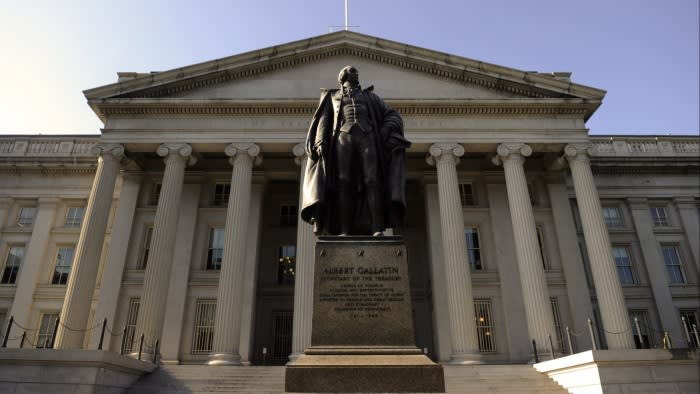Unlock the Editor’s Digest for free
Roula Khalaf, Editor of the FT, selects her favourite stories in this weekly newsletter.
Investors are piling back into bonds as recession replaces inflation as markets’ main fear, and fixed income proves its worth as a hedge against the recent stock market chaos.
US Treasuries and other highly rated debt staged a powerful rally during last week’s equity rout, pulling yields to their lowest level in more than a year. While the sharpest moves subsequently reversed, fund managers say they underscored the appeal of bonds in an environment where growth is slowing, inflation is falling, and the Federal Reserve — along with other major central banks — is expected to deliver multiple cuts in interest rates by the end of the year.
Investors have poured $8.9bn into US government and corporate bond funds in August, building on inflows of $57.4bn in July, which marked the highest monthly figure since January and the second-biggest since mid-2021, according to flow tracker EPFR. High-grade corporate debt has seen 10 weeks of positive flows, the longest streak in four years.
“The best protection against a downside scenario like a recession is Treasury bonds,” said Robert Tipp, head of global bonds at PGIM Fixed Income.
“The arguments for fixed income are really strong. Sometimes people need a shove to move out of cash. The drop-off in employment has really made that [happen],” said Tipp.
A Bloomberg index that tracks both US government and high-quality corporate bonds has gained 2 per cent since late July, contrasting with a 6 per cent loss for the S&P 500. The biggest gain for bonds came on the day of the employment report when stocks sank sharply.

Expectations for Fed rate cuts have shifted dramatically since the weak US jobs report in early August, which showed an unexpected rise in the jobless rate to 4.3 per cent in July from 4.1 per cent in June and that employers added far fewer positions than economists had expected.
Traders in the futures market are now expecting the Fed to cut interest rates by just over one percentage point by year-end, implying at least one extra large half-point cut in the Fed’s remaining three meetings of 2024. Before the August payrolls report, traders were only banking on three quarter-point cuts.
That means safer bonds, such as investment grade credit and Treasuries, now offer high yields but without the threat of further rises in Fed borrowing costs that knocked markets earlier in the year, according to Rick Rieder, chief investment officer of global fixed income at BlackRock.
“People don’t like losing money in fixed income,” he said. “But I think you can, today, feel certain that the Fed will not raise interest rates again. The yields available and the rate of return in fixed income today are so attractive. I would anticipate more money will come into fixed income.”
Corporate debt was also swept up in last week’s sell-off. But the moves were more muted than the big swings in stocks, particularly in the market for high-quality investment grade credit issued by companies where even a US recession is unlikely to triggers large numbers of defaults.
Even “junk”-rated bonds held up better than equities, where high-flying tech companies have been punished with hefty share price declines in recent weeks.
A Bloomberg index of US high yield debt lost just 0.6 per cent in last Monday’s global sell-off in risky assets, compared with a 3 per cent drop in the S&P 500.
“Credit has held up really well versus the volatility we’ve seen in equities,” said Dan Ivascyn, chief investment officer at bond investing giant Pimco. “We don’t want to be super aggressive there, but you’ve had over the last couple of weeks material widening in high-yield corporate bond spreads. We’re not there yet, but if we continue to see weakness there that’s an area of interest.”
Despite the recent inflows, some market participants remain nervous of the implications of an economic slowdown for corporate bonds.
“The risk for credit is that we do get some weaker employment data, we get some weaker growth data,” said Ashok Bhatia, Neuberger Berman’s co-chief investment officer of fixed income.
The outlook for inflation is likely to prove crucial, given the scale of rate cuts now priced in to markets. Data on Wednesday is expected to show a small decline in US consumer inflation to an annual rate of 2.9 per cent in July. An unexpected rise could see investors reining in their rate cut bets, hurting bonds.
“I think bonds are back,” Bhatia said. “But the thing that will support credit at these levels will be the concept that the Fed will react quickly and get the policy rate down” if signs of weakness persist.
“Anything that suggests the Fed will not do that is going to be problematic for credit,” he added.

